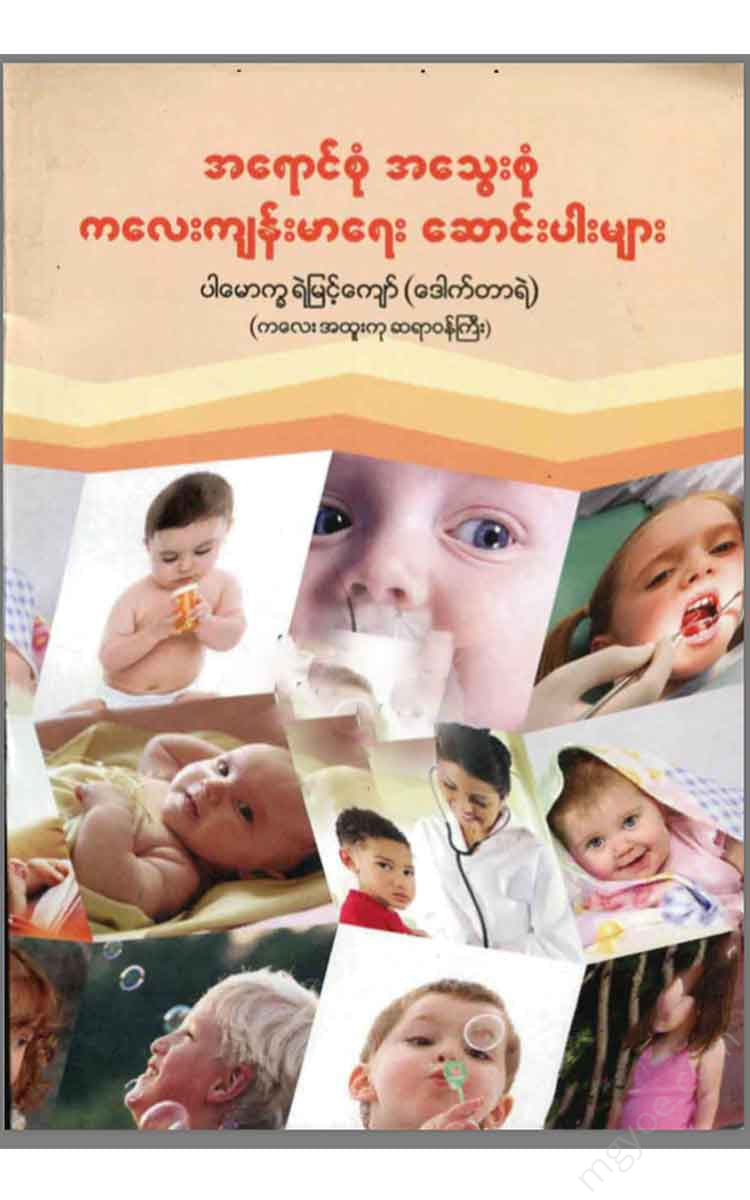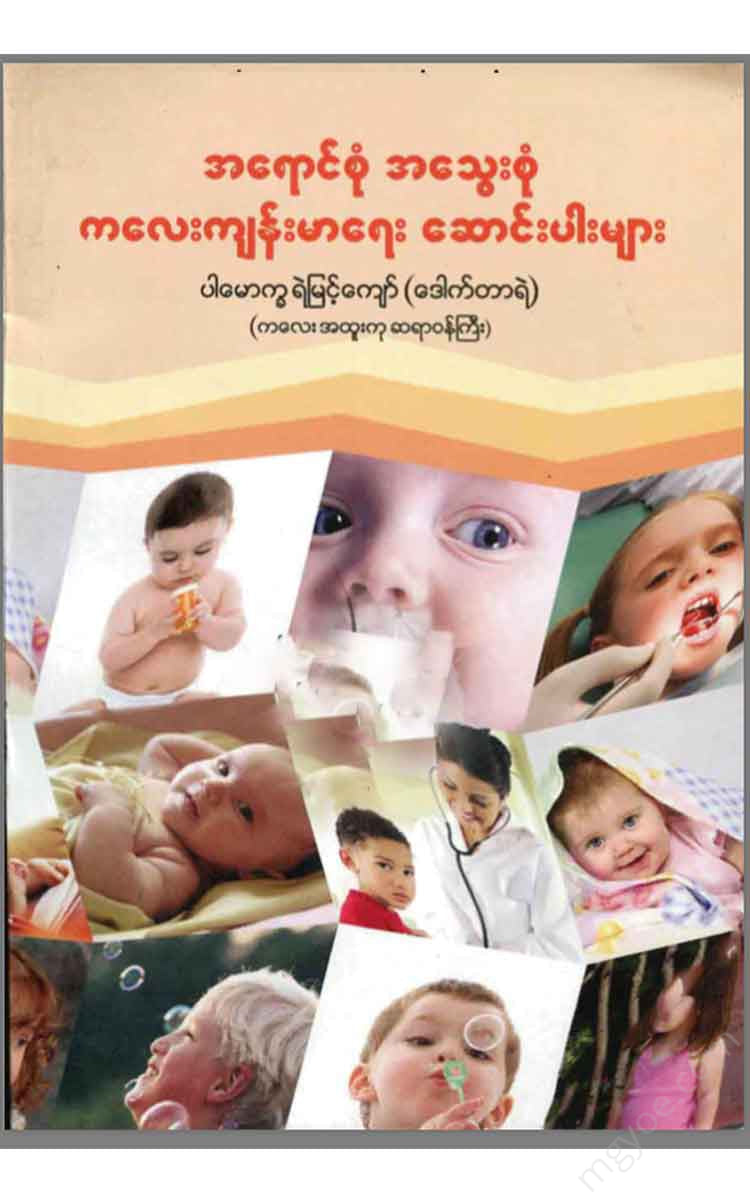Other Websites
Professor Ye Myint Kyaw (Dr. Ye) - Colorful articles on child health
Professor Ye Myint Kyaw (Dr. Ye) - Colorful articles on child health
Couldn't load pickup availability
What is blood cancer?
I have been writing a series of articles on children's health education in various magazines for a long time. I have never written about leukemia. The reason is that I do not intend to write about diseases in detail like medical students, but only want to inform parents about common and preventable problems.
Leukemia is the number one cancer among all childhood cancers, but it is not a public health problem because it is so rare in childhood. It is also not yet a specific preventable disease.
However, nowadays, in Korean dramas, when all the problems of the actress and the actor are solved and they get married, the leukemia often comes in as a villain in the form of a foreign doctor who is approved by the parents in old Burmese movies. Since the main audience of Korean dramas is also mothers of children, they start calling the doctor because their child has a nosebleed and is afraid of leukemia.
In fact, if there are 100,000 children with nosebleeds that are not leukemia, I don't think there will be one who has it because of leukemia. I've only seen one Korean movie where nosebleeds are not leukemia, and it's called 'April Snow'.
I have written a lot about nosebleeds. So this time I will write directly about "leukemia."
What is leukemia?
Leukemia is a cancer that occurs when there are too many white blood cells (WBC) in the blood, and the excess white blood cells are abnormal, in other words, immature white blood cells ( blast cells).
There are many reasons why white blood cells can be high. Even a simple cold can cause them to increase. An illness like whooping cough can cause them to increase dramatically. If you are not careful, you may even find immature white blood cells (blast cells). So, don't assume that every time you see a high white blood cell count in your blood test for any reason, it's leukemia. This is something that a pathologist or hematologist will examine and decide. If they are not sure, they will take a small sample of bone marrow from your breastbone, below your knee, or above your hip bone and confirm that the blast cells are growing in your bone marrow.
According to UK statistics, about one in 1,000 children under the age of 15 are at risk of developing leukemia. Only four in 100,000 new cases are diagnosed in a year. It is difficult to estimate the incidence in Myanmar, but we estimate that it is much lower.
There are four main types of leukemia, but the most common type of leukemia in children is Acute Lymphoblastic Leukemia (ALL). It accounts for about 80 percent of cases. It is also the most treatable type, with a five-year survival rate of over 80 percent. When I worked in Scotland, the head nurse of the pediatric ward at the hospital I worked at told me that her 13-year-old daughter had been treated for the same disease in the same ward. She was about 40 at the time, which was heartwarming.
Why does blood cancer occur?
To put it simply, no one knows.
It is also more common in children with genetic disorders such as Down' syndrome. It can also occur very early, under the age of six months. It doesn't happen to everyone.
There are also some conclusions to be drawn from environmental factors such as radiation exposure, severe viral infections, and certain medications. One thing we can say for sure is that, as parents worry, children who are exposed to X-rays at most two or three times a year will not be harmed by the radiation. In the UK, we have seen children on ventilators in intensive care units receiving at least one X-ray a day for weeks at a time.
If it is leukemia
The child will become weak and lose appetite. This also happens to normal children, so it is not noticeable.
The skin will become pale. You will often get sick. You will cough. Small red spots and large blue spots that bleed often appear on the skin.
Nosebleeds. I have often written about this in the past, but I don't want to confuse it with the frequent nosebleeds that occur due to frequent nosebleeds, such as frequent picking of the nose with your hand, excessive sun exposure, fever, and excessive nasal discharge. This local cause of unilateral nosebleeds is quite common. I remember when I was a child, when I came home from school, a white snot would come out on one side of my nose. It disappeared. However, when I was 36 years old, I went to the UK to take the Royal Medical Examination and the weather was freezing at 12-C, and the nosebleeds started again. This is not scary. If you pinch the nose with your finger and thumb and ask the child to breathe through their mouth for three minutes, it will stop. No need to pack it. No need to apply ice. Bleeding is common in leukemia. However, the child has been bleeding from the nose for years. If there are no other symptoms other than the nosebleeds, it is unlikely to be leukemia.
Children's bones and joints also become painful and painful. The liver and spleen enlarge, and the stomach often swells.
Small lumps also occur. It is not certain that all children have lumps in the neck and groin, as they tend to have more or less. In leukemia, lumps often appear above the elbow and in the armpit (without any surrounding sores).
In rare cases, the disease can spread to the brain, causing severe headaches and vomiting. In boys, the testicles may enlarge.
If leukemia is suspected
Consult with experienced doctors. Now, both in Yangon and Mandalay, there are specialized departments and doctors for pediatric hematology and pediatric cancer. Listen to what they tell you.
Usually, if leukemia is found to be very suspicious, the bone marrow test I wrote about earlier is done. Red blood cells and serum are often transfused. Cancer drugs are given. Cancer drugs are quite strong, and can cause hair loss, mouth ulcers, loss of appetite, and a weakened immune system.
All the steps explained earlier should be discussed openly with a qualified professional regarding what to do and what not to do with your child. In this type of disease, professionals always leave the decision to the patient.
Do not consult with relatives and friends who are not doctors. These are very complex diseases and treatments. Do not accept advice from anyone who pretends to be an expert. Those who give advice will often advise you to doubt everything the doctors say and will force you to try unscientific treatments.
Should you go abroad for treatment?
In Myanmar, there are experts and equipment for this disease, at least in Yangon and Mandalay. They are also providing treatment.
Bone marrow transplants are not yet available. Bone marrow transplants are not necessary for all types of leukemia. Especially in children, salgonp:com cam? 2096 opol Acute Lymphoblastic Leukaemia rarely requires a bone marrow transplant. If they do, the chance of finding a match among siblings who do not have identical twins is only 25 percent. Parents are only half-matched. Never completely. Therefore, if a match cannot be found among siblings, it is very difficult to find a match even abroad.
The cost of medical treatment, foreign dental treatment, medicines and tests in Myanmar is not small. Foreign dental treatment will cost many times more. It is not something that can be done in one go like surgery. It requires repeated treatments over at least two years.
I want them to decide whether they can succeed with their own strength or not, and whether they can be truly beneficial or not, after fully and openly discussing it with local experts.
I can't discuss with Dr. Ye. Dr. Ye is a pediatrician who specializes in general medicine and a little pediatric cardiology. And he is very knowledgeable. May the children be free from leukemia.
About polio
Like every year, National Immunization Days were celebrated twice this year on 3-11-07 and 2-12-07 as part of the polio eradication program.
This year, just after the National Immunization Day (2nd time), I went to Mandalay to conduct the final year MBBS Part (B) students of Mandalay University of Medicine for the practical examination of pediatric health education. While I was there, I also gave a lecture and discussion with pediatricians in Mandalay at the Myanmar Medical Association (Mandalay Branch).
The topic I spoke about in the lecture was Update on Immunization (the latest information on vaccination and the pharmacy industry).
The child also spoke about polio. The chairman was Professor Pe Thet Khin, who I have been quoting in my articles for many years and who I respect and love like an older brother. He is now the dean. He also explained polio to the children in great detail.
At that moment, Wellness called me and asked me to write an article. Polio was on my mind, so I wanted to write a little about polio, the vaccine, and the fight against polio.
What is polio?
Polio is a disease caused by a virus called poliovirus that causes paralysis of the limbs and nerves. There are three types of poliovirus, but 85% of polio cases are caused by the first type (Type 1).
It is transmitted through contaminated water and food. Once inside the body, it “multiplies” in the lining of the esophagus, intestines, and palate for about one to three weeks. The virus is shed in saliva for only two to three days, but remains in the stool for two to three weeks. It is highly contagious. 95% of people infected with polio have no symptoms or develop a mild flu-like illness. Some children develop a secondary infection.

